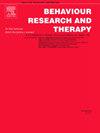儿童焦虑和强迫症的代价回避——情绪反应和奖励敏感性的影响
IF 4.2
2区 心理学
Q1 PSYCHOLOGY, CLINICAL
引用次数: 0
摘要
内在化的精神障碍,如强迫症(OCD)和焦虑症的一个中心特征是避免有回报的情况,以防止经历痛苦情绪的风险。先前的研究表明,强迫和焦虑的人会避免以厌恶经历为代价获得奖励的情况,这种现象被称为“代价回避”。以前没有在患有强迫症或焦虑症的青少年的临床样本中研究过昂贵的逃避行为,这是一个重要的空白,因为这些疾病通常在生命的前20年发病。在这项研究中,寻求治疗的青少年强迫症(n = 62)和焦虑症(n = 43),以及对照组的青少年无精神障碍(n = 47)执行了一项回避冲突的任务。参与者被选择面对中立的结果,或者获得与令人厌恶的图像和声音同时出现的奖励。结果显示,与非临床对照组相比,强迫症和焦虑症组的逃避成本更高,但两组临床组之间没有差异。特质奖励敏感性和对厌恶声音和图像的主观消极情绪反应是代价回避的最佳个体预测因子。我们的研究结果表明,患有强迫症和焦虑症的青少年表现出较高的成本回避水平,这与临床理论和先前在成人焦虑症患者中的发现一致。我们还表明,这些高水平的代价回避可以用奖励敏感性和情绪反应性的个体差异来最好地解释,这表明对食欲和厌恶结果的敏感性可能是不适应代价回避差异的基础。本文章由计算机程序翻译,如有差异,请以英文原文为准。
Costly avoidance in pediatric anxiety and OCD - The impact of emotional reactivity and reward sensitivity
A central feature of internalizing mental disorders, such as obsessive-compulsive disorder (OCD) and anxiety disorders, is the avoidance of rewarding situations to prevent the risk of experiencing distressing emotions. Previous research has shown that obsessive and anxious individuals avoid situations where rewards come at the cost of aversive experiences, a phenomenon termed costly avoidance. Costly avoidance has not previously been examined in clinical samples of youths with OCD or anxiety disorders, which is an important gap as these disorders typically onset during the first two decades of life. In this study, treatment-seeking youths with OCD (n = 62) and anxiety disorders (n = 43), and a comparison group of youths without mental disorders (n = 47) performed an approach-avoidance conflict task. Participants selected to face either neutral outcomes or to obtain rewards that co-occurred with aversive images and sounds. Results showed more costly avoidance in the OCD and anxiety disorder groups compared to the non-clinical comparison group, but no differences between the two clinical groups emerged. Trait reward sensitivity and subjective negative emotional reactions to aversive sounds and images were the best individual predictors of costly avoidance. The results of our study show that youths with OCD and anxiety disorders display elevated levels of costly avoidance, which is in line with clinical theories and previous findings in adults with anxiety disorders. We also show that these elevated levels of costly avoidance are best explained by individual differences in reward sensitivity and emotional reactivity, suggesting that sensitivity to appetitive and aversive outcomes might underlie differences in maladaptive costly avoidance.
求助全文
通过发布文献求助,成功后即可免费获取论文全文。
去求助
来源期刊

Behaviour Research and Therapy
PSYCHOLOGY, CLINICAL-
CiteScore
7.50
自引率
7.30%
发文量
148
期刊介绍:
The major focus of Behaviour Research and Therapy is an experimental psychopathology approach to understanding emotional and behavioral disorders and their prevention and treatment, using cognitive, behavioral, and psychophysiological (including neural) methods and models. This includes laboratory-based experimental studies with healthy, at risk and subclinical individuals that inform clinical application as well as studies with clinically severe samples. The following types of submissions are encouraged: theoretical reviews of mechanisms that contribute to psychopathology and that offer new treatment targets; tests of novel, mechanistically focused psychological interventions, especially ones that include theory-driven or experimentally-derived predictors, moderators and mediators; and innovations in dissemination and implementation of evidence-based practices into clinical practice in psychology and associated fields, especially those that target underlying mechanisms or focus on novel approaches to treatment delivery. In addition to traditional psychological disorders, the scope of the journal includes behavioural medicine (e.g., chronic pain). The journal will not consider manuscripts dealing primarily with measurement, psychometric analyses, and personality assessment.
 求助内容:
求助内容: 应助结果提醒方式:
应助结果提醒方式:


